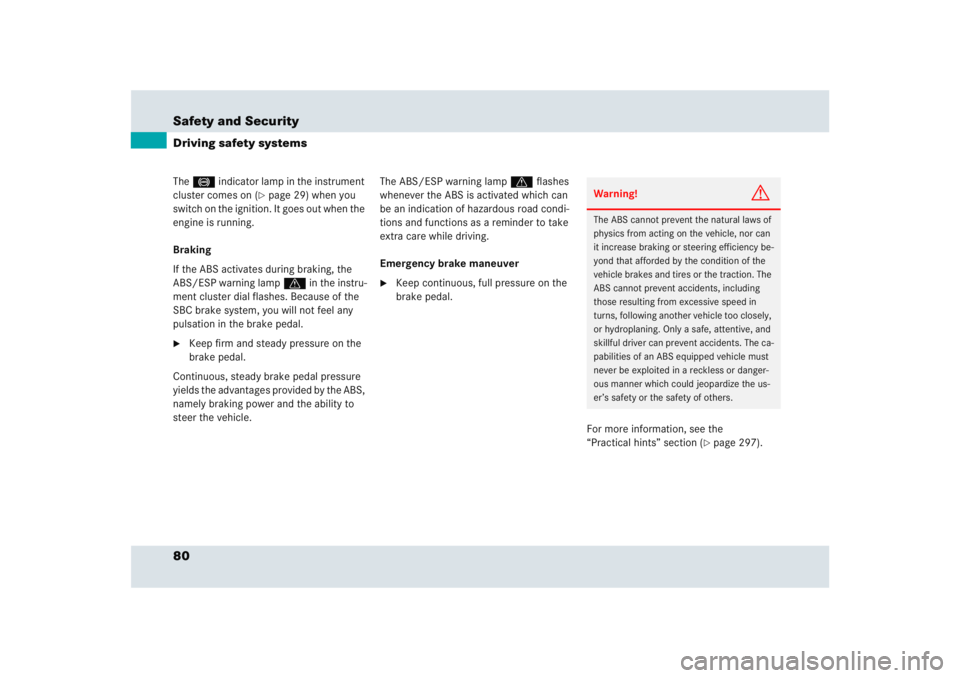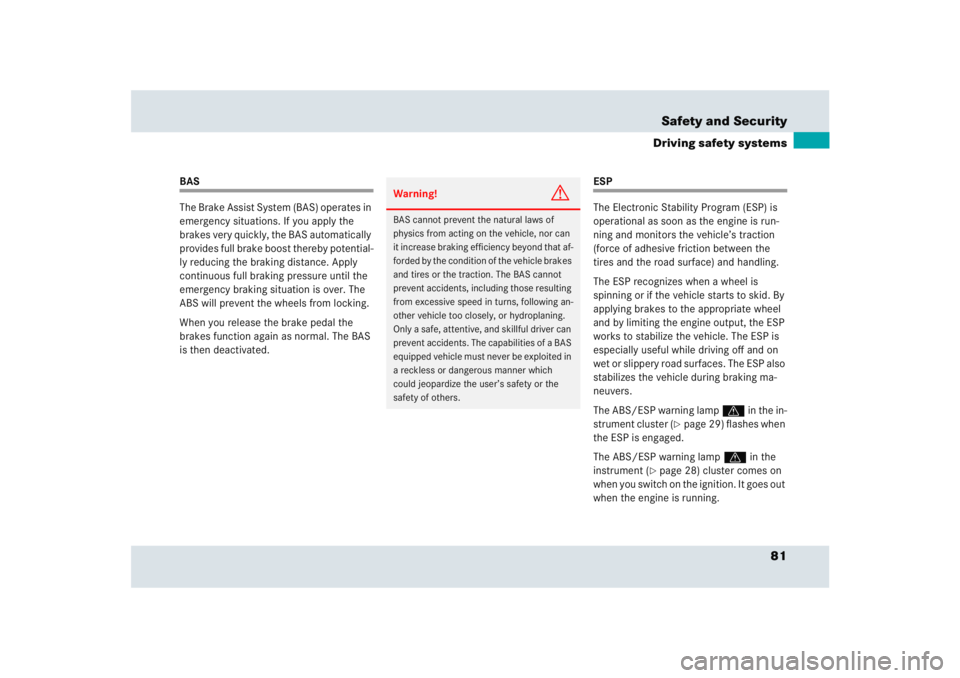Page 41 of 417

40 Getting startedUnlockingStarter switch positionsStarter switch
0For removing SmartKey
1Power supply for some consumers
2Ignition (power supply for all consum-
ers) and drive position. All lamps (ex-
cept high beam headlamp indicator
lamp and turn signal indicator lamps
unless activated) in the instrument
cluster come on. If a lamp in the instru-
ment cluster fails to come on when the
ignition is switched on, have it checked
and replaced if necessary. If a lamp in
the instrument cluster remains on after
starting the engine or comes on while
driving, see “Lamps in instrument clus-
ter” (
�page 296).
Warning!
G
When leaving the vehicle, always remove the
SmartKey from the starter switch, take it
with you, and lock the vehicle. Do not leave
children unattended in the vehicle, or with
access to an unlocked vehicle. Unsuper-
vised use of vehicle equipment may cause
an accident and/or serious personal injury.
iWhen you switch on the ignition, the
indicator and warning lamps (except
high beam headlamp indicator lamp
and turn signal indicator lamps if acti-
vated) in the instrument cluster come
on. This indicates that the respective
systems are operational. They should
go out when the engine is running.
!If the SmartKey is left in the starter
switch position0 for an extended peri-
od of time, it can no longer be turned in
the starter switch. �
Remove the SmartKey from the
starter switch and reinsert.
If the SmartKey can still not be turned
in the starter switch, the starter battery
may not be sufficiently charged.
�
Have the starter battery checked
and charged if necessary
(�page 355). Contact an autho-
rized Mercedes-Benz Center.
To prevent accelerated battery
discharge and a possible dead battery,
always remove the SmartKey from the
starter switch when the engine is not in
operation.
Page 45 of 417
44 Getting startedAdjustingThe buttons are located on the lower part
of the center console.
1Driver’s side exterior rear view mirror
button
2Passenger-side exterior rear view mir-
ror button
3Adjustment button
�
Switch on the ignition (
�page 40).
�
Press button1 for the driver’s side
exterior rear view mirror or button2
for passenger-side exterior rear view
mirror.
�
Push adjustment button3 up, down,
left, or right according to the desired
setting.
For more information, see “Rear view mir-
rors” (
�page 179).
iAt low ambient temperatures, the
exterior rear view mirrors will be
heated automatically.
Page 49 of 417
48 Getting startedDrivingStarting the engine
Gearshift pattern P Park position with gear selector lever
lock
R Reverse gear
N Neutral
D Drive position
For more information, see “Automatic
transmission” (
�page 167).1Cover
2Start button
�
Make sure the gear selector lever is set
toP.
�
Do not depress the accelerator.
�
Switch on the ignition (
�page 40).
�
Lift up cover1.
�
Press the start button2 once.
The engine starts automatically.
Warning!
G
Inhalation of exhaust gas is hazardous to
your health. All exhaust gas contains carbon
monoxide, and inhaling it can cause uncon-
sciousness and lead to death.
Do not run the engine in confined areas
(such as garage) which are not properly ven-
tilated. If you think that exhaust gas fumes
are entering the vehicle while driving, have
the cause determined and corrected imme-
diately. If you must drive under these condi-
tions, drive only with at least one window
fully open.
Page 53 of 417
52 Getting startedDrivingTurn signals
The combination switch is located on the
left of the steering column.Combination switch1Turn signals, right
2Turn signals, left
�
Press the combination switch up 1 or
down 2.
The corresponding turn signal indicator
lampL orK in the instrument
cluster flashes.
The combination switch automatically
returns to its original position once the
steering wheel has been turned far
enough.
Windshield wipers
The combination switch is located on the
left of the steering column.Combination switch1Single wipe
2Switching on windshield wipers�
Switch on the ignition (
�page 40).
iTo signal minor directional changes,
such as a lane change, move combina-
tion switch to point of resistance only
and release. The turn signal flashes
three times.
Page 55 of 417

54 Getting startedDriving
Problems while driving
The engine runs erratically and misfires�
An ignition cable may be damaged.
�
The engine electronics may not be op-
erating properly.
�
Unburned gasoline may have entered
the catalytic converter and damaged it.
�
Give very little gas.
�
Have the problem repaired by an au-
thorized Mercedes-Benz Center as
soon as possible.
!If anything blocks the windshield
wipers (leaves, snow, etc.), switch
them off immediately.�
For safety reasons, withdraw
SmartKey from starter switch
before attempting to remove any
blockage.
�
The hood must be opened
(�page 243) before folding the
wiper arms away from the wind-
screen. You could otherwise dam-
age the hood and/or the wiper arm.
�
Remove blockage.
�
Turn the windshield wipers on
again.
If windshield wipers fail to function at
all in switch positionI,�
set the combination switch to the
next highest wiper speed
�
have the windshield wipers
checked at the nearest authorized
Mercedes-Benz Center
Page 81 of 417

80 Safety and SecurityDriving safety systemsThe - indicator lamp in the instrument
cluster comes on (
�page 29) when you
switch on the ignition. It goes out when the
engine is running.
Braking
If the ABS activates during braking, the
ABS/ESP warning lamp v in the instru-
ment cluster dial flashes. Because of the
SBC brake system, you will not feel any
pulsation in the brake pedal.
�
Keep firm and steady pressure on the
brake pedal.
Continuous, steady brake pedal pressure
yields the advantages provided by the ABS,
namely braking power and the ability to
steer the vehicle.The ABS/ESP warning lamp v flashes
whenever the ABS is activated which can
be an indication of hazardous road condi-
tions and functions as a reminder to take
extra care while driving.
Emergency brake maneuver
�
Keep continuous, full pressure on the
brake pedal.
For more information, see the
“Practical hints” section (
�page 297).
Warning!
G
The ABS cannot prevent the natural laws of
physics from acting on the vehicle, nor can
it increase braking or steering efficiency be-
yond that afforded by the condition of the
vehicle brakes and tires or the traction. The
ABS cannot prevent accidents, including
those resulting from excessive speed in
turns, following another vehicle too closely,
or hydroplaning. Only a safe, attentive, and
skillful driver can prevent accidents. The ca-
pabilities of an ABS equipped vehicle must
never be exploited in a reckless or danger-
ous manner which could jeopardize the us-
er’s safety or the safety of others.
Page 82 of 417

81 Safety and Security
Driving safety systems
BAS
The Brake Assist System (BAS) operates in
emergency situations. If you apply the
brakes very quickly, the BAS automatically
provides full brake boost thereby potential-
ly reducing the braking distance. Apply
continuous full braking pressure until the
emergency braking situation is over. The
ABS will prevent the wheels from locking.
When you release the brake pedal the
brakes function again as normal. The BAS
is then deactivated.
ESP
The Electronic Stability Program (ESP) is
operational as soon as the engine is run-
ning and monitors the vehicle’s traction
(force of adhesive friction between the
tires and the road surface) and handling.
The ESP recognizes when a wheel is
spinning or if the vehicle starts to skid. By
applying brakes to the appropriate wheel
and by limiting the engine output, the ESP
works to stabilize the vehicle. The ESP is
especially useful while driving off and on
wet or slippery road surfaces. The ESP also
stabilizes the vehicle during braking ma-
neuvers.
The ABS/ESP warning lamp v in the in-
strument cluster (
�page 29) flashes when
the ESP is engaged.
The ABS/ESP warning lamp v in the
instrument (
�page 28) cluster comes on
when you switch on the ignition. It goes out
when the engine is running.
Warning!
G
BAS cannot prevent the natural laws of
physics from acting on the vehicle, nor can
it increase braking efficiency beyond that af-
forded by the condition of the vehicle brakes
and tires or the traction. The BAS cannot
prevent accidents, including those resulting
from excessive speed in turns, following an-
other vehicle too closely, or hydroplaning.
Only a safe, attentive, and skillful driver can
prevent accidents. The capabilities of a BAS
equipped vehicle must never be exploited in
a reckless or dangerous manner which
could jeopardize the user’s safety or the
safety of others.
Page 89 of 417

88 Safety and SecurityPerformance enhancement systemThe Airbrake switch is on the upper part of
the center console.Airbrake modes1Manual
2Automatic
3Test
4Airbrake switch�
Switch on the ignition (
�page 40).
The system runs a self-test to ensure
correct operation of the Airbrake.Test mode
The test mode allows you to check that the
Airbrake is functioning correctly.
This mode can only be activated when the
vehicle is at standstill.
�
Slide Airbrake switch4 to
position3.
The Airbrake swings upwards to an an-
gle of 62°.
�
Release the Airbrake switch.
The Airbrake returns to its initial posi-
tion.Manual mode
In this mode, the Airbrake is set to an angle
of 30°. The driver downforce mode en-
hances handling in all conditions.
�
Slide the Airbrake switch4 to
position1.
The Airbrake swings upwards to an an-
gle of 30° and stays in this position.iIn manual mode, the Airbrake automat-
ic function is activated in an emergency
braking situation, see “Automatic
mode” (
�page 89).
!Before deactivating manual mode,
check the Airbrake for any objects
which may have become lodged, e.g.
branches or leaves, and remove them.
Otherwise the Airbrake can no longer
function correctly.